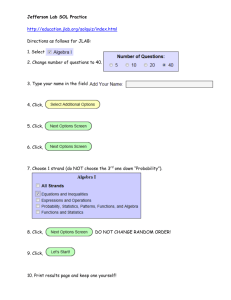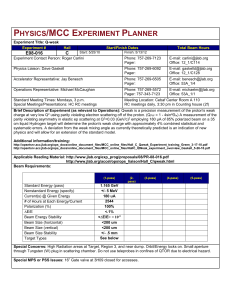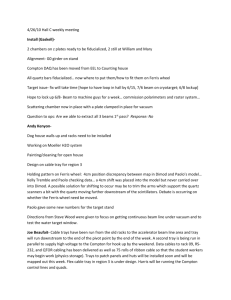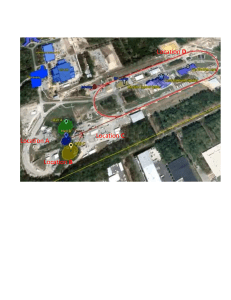Proposal - Jefferson Science Associates, LLC
advertisement
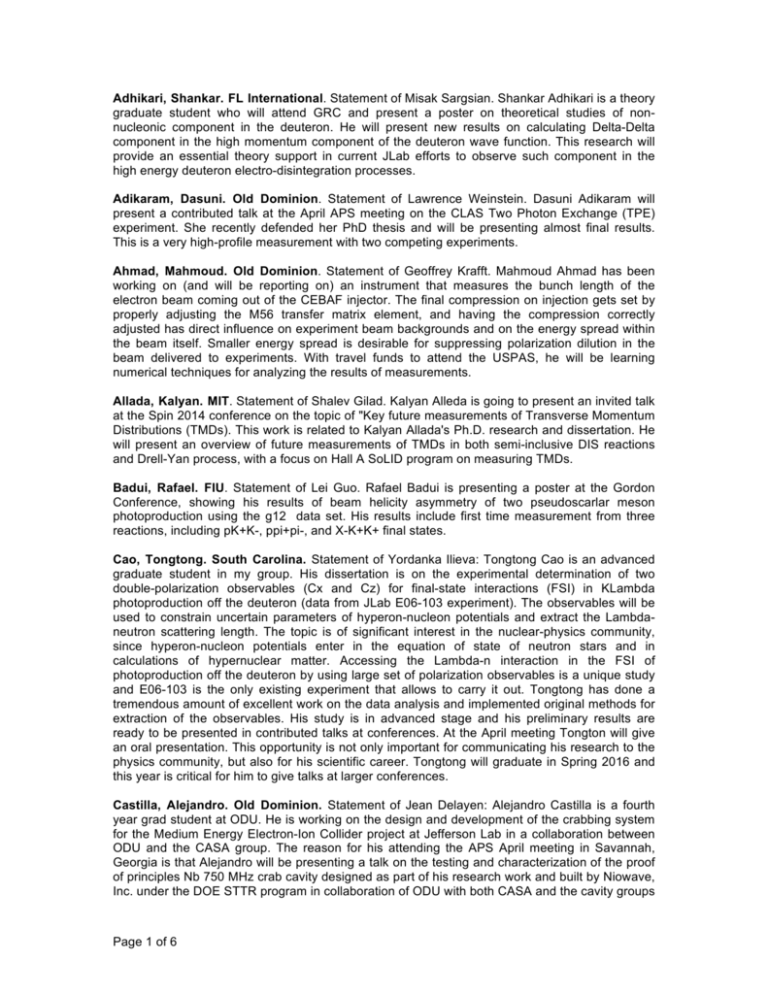
Adhikari, Shankar. FL International. Statement of Misak Sargsian. Shankar Adhikari is a theory graduate student who will attend GRC and present a poster on theoretical studies of nonnucleonic component in the deuteron. He will present new results on calculating Delta-Delta component in the high momentum component of the deuteron wave function. This research will provide an essential theory support in current JLab efforts to observe such component in the high energy deuteron electro-disintegration processes. Adikaram, Dasuni. Old Dominion. Statement of Lawrence Weinstein. Dasuni Adikaram will present a contributed talk at the April APS meeting on the CLAS Two Photon Exchange (TPE) experiment. She recently defended her PhD thesis and will be presenting almost final results. This is a very high-profile measurement with two competing experiments. Ahmad, Mahmoud. Old Dominion. Statement of Geoffrey Krafft. Mahmoud Ahmad has been working on (and will be reporting on) an instrument that measures the bunch length of the electron beam coming out of the CEBAF injector. The final compression on injection gets set by properly adjusting the M56 transfer matrix element, and having the compression correctly adjusted has direct influence on experiment beam backgrounds and on the energy spread within the beam itself. Smaller energy spread is desirable for suppressing polarization dilution in the beam delivered to experiments. With travel funds to attend the USPAS, he will be learning numerical techniques for analyzing the results of measurements. Allada, Kalyan. MIT. Statement of Shalev Gilad. Kalyan Alleda is going to present an invited talk at the Spin 2014 conference on the topic of "Key future measurements of Transverse Momentum Distributions (TMDs). This work is related to Kalyan Allada's Ph.D. research and dissertation. He will present an overview of future measurements of TMDs in both semi-inclusive DIS reactions and Drell-Yan process, with a focus on Hall A SoLID program on measuring TMDs. Badui, Rafael. FIU. Statement of Lei Guo. Rafael Badui is presenting a poster at the Gordon Conference, showing his results of beam helicity asymmetry of two pseudoscarlar meson photoproduction using the g12 data set. His results include first time measurement from three reactions, including pK+K-, ppi+pi-, and X-K+K+ final states. Cao, Tongtong. South Carolina. Statement of Yordanka Ilieva: Tongtong Cao is an advanced graduate student in my group. His dissertation is on the experimental determination of two double-polarization observables (Cx and Cz) for final-state interactions (FSI) in KLambda photoproduction off the deuteron (data from JLab E06-103 experiment). The observables will be used to constrain uncertain parameters of hyperon-nucleon potentials and extract the Lambdaneutron scattering length. The topic is of significant interest in the nuclear-physics community, since hyperon-nucleon potentials enter in the equation of state of neutron stars and in calculations of hypernuclear matter. Accessing the Lambda-n interaction in the FSI of photoproduction off the deuteron by using large set of polarization observables is a unique study and E06-103 is the only existing experiment that allows to carry it out. Tongtong has done a tremendous amount of excellent work on the data analysis and implemented original methods for extraction of the observables. His study is in advanced stage and his preliminary results are ready to be presented in contributed talks at conferences. At the April meeting Tongton will give an oral presentation. This opportunity is not only important for communicating his research to the physics community, but also for his scientific career. Tongtong will graduate in Spring 2016 and this year is critical for him to give talks at larger conferences. Castilla, Alejandro. Old Dominion. Statement of Jean Delayen: Alejandro Castilla is a fourth year grad student at ODU. He is working on the design and development of the crabbing system for the Medium Energy Electron-Ion Collider project at Jefferson Lab in a collaboration between ODU and the CASA group. The reason for his attending the APS April meeting in Savannah, Georgia is that Alejandro will be presenting a talk on the testing and characterization of the proof of principles Nb 750 MHz crab cavity designed as part of his research work and built by Niowave, Inc. under the DOE STTR program in collaboration of ODU with both CASA and the cavity groups Page 1 of 6 at the Jefferson Lab. An efficient crabbing system is crucial for the MEIC in achieving the luminosity specifications required by the Nuclear Physics Program on their quest of further understanding of the matter. Alejandro's work span covers computational simulations for radiofrequency structure design, superconductivity, experimental aspects of microwaves and cavity testing, beam dynamics and particle tracking. Celentano, Andrea. INFN-Genova. Statement of Marco Battaglieri: MeV-GeV dark matter (DM) is theoretically well motivated but remarkably unexplored. The “Beam Dump eXperiment” (BDX) at Jefferson Laboratory aims to search for low-mass dark matter, trough the scattering on a segmented plastic scintillator detector placed downstream of the beam-dump at one of the high 22 intensity JLab experimental Halls, receiving up to 10 electrons-on-target (EOT) in a one-year period. For these experimental conditions, BDX is sensitive to the DM-nucleon elastic scattering at the level of a thousand counts per year, and is only limited by cosmogenic backgrounds. The experiment is also sensitive to DM-electron elastic and inelastic scattering, at the level of 10 counts/year. The foreseen signal for this channel is an high-energy (> 100 MeV) electromagnetic shower, with almost no background. The experiment, currently being designed, has been presented in form of a Letter of Intent to the laboratory, receiving positive feedback. This encouraged the preparation of a full proposal, to be submitted to the next year PAC. In the talk, after briefly discussing the motivations for low-mass dark matter existence, we will describe the experimental setup, and show the foreseen experimental sensitivity for the two aforementioned channels, obtained trough Monte Carlo simulations. Celentano, Andrea. INFN-Genova. Statement of Marco Battaglieri: Andrea will present an update on the analysis of the decay process w → 3 pi employing an extended Veneziano model. Data were obtained by measuring the reaction gamma p → p pi+ pipi0 with the CLAS detector in Hall-B at Jefferson Laboratory. The workshop will be a very good occasion to show these results to the international experts there present, and to trigger a fruitful discussion. Compton, Nicholas. Ohio. Statement of Ken Hicks: Nick will present his cross sections for K0 Lambda photoproduction from the neutron. This is the first time that these results will be shown publicly. These data are important for the understanding of neutron resonances, which may have different photo-couplings than for proton resonances. Compton, Nicholas. Ohio. Statement of Ken Hicks: This request is to attend the CLAS12 European Collaboration Meeting, which will be held in Catania, Sicily, Italy on February 17-20, 2015. Nick will be representing the Ohio University group. Nick will present a talk on his analysis of the K0 Lambda photoproduction from the neutron, which has passed analysis review and is about to start Ad Hoc review. Cummings, Melissa. William & Mary. Statement of Todd Averett: Melissa Cummings will attend the SPIN 2014 conference to present new results on her thesis experiment, A Measurement of g2p at Low Q2. The collaboration expects to have preliminary results to show. This conference is the appropriate venue for these results because they are the first measurements of this fundamental structure function in the resonance region. Results will be used to test the BurkhardtCottingham sum rule and chiral perturbation theory calculations of nucleon polarizabilities. Dai, Lingyun. Indiana U. Statement of Adam Szczepaniak: Lingyun is a postdoc of Indiana University, partly working on JLab physics and requests travel support to attend the Future Directions in Spectroscopy Analysis workshop at JLab in November at which Lingyuan will make a presentation. Fegan, Stuart. INFN. Statement of Marco Battaglieri: The MESON2014 workshop aims to establish closer contact between experimentalists and theorists studying meson production, properties and interactions. The program and themes of the workshop offer a good match to my current involvement in the MesonEx experiment at JLab and an ideal opportunity to showcase the work of the collaboration to the wider hadron physics community. Page 2 of 6 Freese, Adam. Florida International. Statement of Misak Sargsian. Adam Freese is a theory graduate student who will attend GRC and present a poster on theoretical studies of EMC effects at JLab 6/12 GeV and EIC energies. New calculations will be presented which systematically take into account the short range correlations effects in partonic distribution modification in the nuclear medium. Garillon, Brice. IPN Orsay. Statement of Silvia Niccolai. Brice Garillon will attend the CLAS12 4th European workshop where he will present the near-to-final results of his PhD thesis analysis on electroproduction of the f0 and f2 mesons measured with the CLAS detector. Brice is a third year PhD student who has made remarkable progress since beginning his thesis, and has reached a very good level of maturity, physics knowledge as well as familiarity and expertise with the data analysis tools. Presenting his results in this international workshop can help him get feedback to improve and conclude his thesis work and at the same time provide him with the exposure he needs to find a job to pursue a career in research. Hattawy, Mohammad. Université Paris-Sud / Institut de Physique Nucléaire d'Orsay. Statement of Michel Guidal & Raphaël Dupré. Misak Sargsian. Mohammad has been working on calibration and analysis of the eg6 run of CLAS for 2-1/2 years. He has now preliminary results for the coherent and incoherent deep virtual Compton scattering off 4He. Our experiment is the first to specifically measure these channels, making the results highly original. Mohammad will give a contributed talk at the conference and present these results at the QNP conference for the first time. Jakura, Andrew. Indiana University. Statement of Adam Szczepaniak. Andrew’s PhD work will focus on hadron spectroscopy and reaction mechanisms. Attending the Future Directions in Spectroscopy Analysis workshop at JLab in November directly impacts his future research and would start his professional development in the field. Experts in reaction theory and analysis would introduce him to the current research and applications in hadron spectroscopy. Participation at the workshop will enable him ability to meet people that he will be collaborating with in the future. Ma, Lingling. UNC-Wilmington. Statement of Liping Gan: A poster presentation on the status of PrimEx-II will be presented. Magee, Joshua. William & Mary. Statement of David Armstrong: Josh Magee has been invited to present a talk on Qweak at the Quark Confinement and the Hadron Spectrum Conference this September in St Petersburg, Russia. Josh is an advanced PhD student. He started graduate studies here at William & Mary in the Fall of 2008 and his thesis project is Qweak. The collaboration received a request to give an invited talk at this meeting, and the collaboration Talks Coordinator and Institutional Council selected Josh for this talk. Josh gives excellent talks, and will represent the collaboration well. This will be his first invited talk, and his first chance to attend an international conference. Mkrtchyan, Arthur. Catholic U. Statement of Tanja Horn: This request is for partial travel support from JSA for my postdoc Arthur Mkrtchyan to give an oral presentation at the APS 2015 meeting. Arthur is a young scientist working on the analysis of 6 GeV Timelike Compton Scattering (TCS) data and the design of a new 12 GeV TCS experiment with a transverse target. Arthur has an excellent background in hardware development. Currently he is working on two hardware projects needed to carry out CUA's physics program at JLab, the kaon aerogel Cerenkov detector to be installed this summer and the Neutral Particle Spectrometer project. The latter is of great interest for Arthur's studies of a new 12 GeV TCS experiment. Arthur's presentation at the APS 2015 will focus on TCS results from 6 GeV data and opportunities for studies of TCS at 12 GeV including his studies for developing an experiment with transverse target. Giving him an opportunity to present his results at the APS 2015 meeting would allow him to further his skills in communicating scientific results to a scientific audience. Page 3 of 6 Moore, Michael. Old Dominion. Statement of Silviu Covrig: I would like to request travel funds for Michael Moore, a senior grad student from ODU to present a poster at the April 2014 APS Meeting in Savannah, GA. Michael has been instrumental in finding solutions to a critical problem: the SHMS steering of the primary electron beam in Hall C. The SHMS smallest angle was designed to be 5 degrees, but due to the steering of the primary beam the spectromer would only work above 9 degrees as built. Michael has generated for the first time the full 3D SHMS optics system by modeling it with OPERA/TOSCA. He is in the process of finding a solution that will allow the spectrometer to work at 5 degrees over the full range of energies. He is preparing a scientific paper to be submitted to NIM based on his findings. He would like to present the status of his work at the APS-April 2014 meeting. Moriya, Kei. Arizona State. Statement of Barry Ritchie: Kei Moriya has been invited to the workshop to present results on CLAS photoproduction experiments. The organizers have asked for results regarding eta, omega, phi, and Lambda(1405) production. All of these results have been published, and are of interest to the broad community working on hadronic resonances. The Lambda(1405) in particular was Kei's thesis topic, and has garnered attention from theorists as a state that may be "dynamically generated". The workshop provides a chance for Kei to be exposed to the broader community and present high-precision results from Jefferson Lab. Narayan, Amrendra. Mississippi State. Statement of Dipangkar Dutta: I am requesting travel support for Amrendra Narayan who is a senior grad student working on the Qweak experiment. Amrendra was instrumental in developing the FPGA based DAQ system for the electron detector used in the Hall-C Compton polarimeter, which was used during the Qweak experiment. He has been analyzing the Compton data and simulating the whole polarimeter as well as the DAQ system in order and is well on the way to achieving the sub 1% systematic uncertainty desired by the Qweak experiment. He will present a talk on his latest simulation and on his efforts to rigorously demonstrate the sub 1% systematic uncertainty of the electron detector. Peng, Peng. UVa. Statement of Blaine Norum. Peng has been a research student of mine working on preparations for, execution of, and interpretation of the results from the G14 CLAS run. He made considerable contributions to the development of the HD target working in A, Sandorfi's group. Since the run, he has worked on various aspects of the analysis of this pioneering experiment. One of his main efforts has been in the analysis of the NMR measurements of the target polarization, a challenging undertaking given the novelty of the target. He has also made excellent progress in analyzing the two-pion channel (which he plans to present at the conference). In short, he has done an excellent job and will represent the lab with distinction. Phelps, Will. FIU. Statement of Lei Guo. Will Phelps is presenting a poster at the Gordon Conference, showing his results of antibaryon photoproduction using the g12 data set. His data includes the highest statistics ever collected for antibaryon photoproduction, as well as the first observation of antineutron in photoproduction. He will show preliminary data features, cross sections and angular distributions. Prather, Benjamin. Arizona State. Statement of Barry Ritchie: Ben Prather, a senior undergraduate honors student with a 3.75 GPA at ASU, will present a poster on his simulation studies of the feasibility of ηc photoproduction measurements with the GlueX detector, which will be the subject of his honors' thesis at ASU. During his undergraduate work at ASU, he has particpated in both cluster computing and supercomputing teams, which has helped in his implementation of boosted decision trees for his simulation studies. Ben has been accepted by several first-tier graduate schools, so the experience will help him build his profesional network as a budding researcher. Schott, Diane. George Washington. Statement of William Briscoe: Diane is a full time post doc with my GWDAC group. She has been invited to speak at MESON2014 on a topic entitled CLAS Page 4 of 6 Results on Meson Spectroscopy. As you can see this is very much related to not only her thesis experiment, but also her service work to the CLAS Collaboration through the Hall B Partial Wave Analysis Group, and her work in both the GW Data Analysis Center and the JLab Physics Analysis Center. Diane has shown great leadership in these effort and deserves to be recognized for these efforts by the awarding of a JSA Junior Scientist Travel Grant. Sparks, Nathan. Catholic University. Statement of Franz Klein: My postdoc Nathan Sparks will present a new kind of pre-amplifiers for PMTs in the Poster Session of the Nuclear Science Symposium at the IEEE-NPSS Conference in Seattle, WA. Nathan has helped with the development and characterization of this new kind of pre-amplifiers for PMTs that takes its operating voltages from the HV inlet of the PMT. The pre-amp PCB with two independent output channels was developed by Vladimir Popov (JLab) in collaboration with Alexander Somov (JLab) and Franz Klein (CUA) to support high-rate operation of the Hall-D broadband tagging hodoscope. The Hamamatsu 1” PMTs (R9800) are driven by a self-made divider PCB and the anode signal is amplified on a (second) pre-amp PCB. The main advantages of this pre-amplifier are its low current consumption and the absence of extra (low-voltage) cables connected to the PMT-preamp unit. Nathan helped with optimizing the prototype, and he characterized almost all PMT-preamp units for the tagging hodoscope from Dec. 2013 to April 2014 by extensive HV scans and rate scans between 10kHz and 10MHz. During this summer he helped with installation and on-site testing of the 218 counters in the Hall-D Tagger Hall. Thorpe, Brianna. Arizona State. Statement of Barry Ritchie: Brianna Thorpe, a sophomore undergraduate honors student at ASU, will present her poster on the triplet polarimeter to be used in the Hall D beamline for measuring the photon beam polarization. The use of the triplet production process (pair creation off atomic electrons) could allow for determination of polarization with high precision. The newly-constructed polarimeter will be described, preliminary results of the detector's response to alpha and electron sources will be presented, and estimates of potential performance with the Jefferson Lab Hall D photon beam will be discussed. Brianna has won ASU awards and support for her involvement with the ASU Meson Physics Group, has a 3.8 GPA, participated in an REU program last summer, leads an undergraduate student group promoting the involvement of women in science (SUNRISE), and is involved in other outreach activities. Trivedi, Arjun. South Carolina. Statement of Ralf Gothe: Within the context of the N* program at JLab and its overarching goal of probing the evolution of the Strong Interaction's degrees of freedom, Arjun will introduce his analysis of the Charged Double-Pion Electroproduction data off the proton (extended to high Q^2 and W) and his ongoing effort to extract cross-sections that will be used to determine Electrocoupling observables. Given the breadth of the XXI DAE-BRNS High Energy Physics Symposium, Arjun will begin his presentation with an overview of the N* program and the CLAS detector. In presenting his latest results, Arjun will stress on his attempt to extract, for the first time, beam helicity dependent Electrocoupling observables from Double ChargedPion production. Tsai, Cheng-Ying. VA Tech. Statement of Mark Pitt: Based on his merit and qualification, Cheng-Ying Tsai has been accepted by the United States Particle Accelerator School (USPAS), with coverage of room and board. The only part not covered is the transportation costs. ChengYing is working on a Ph.D. thesis in accelerator physics under the direction of Rui Li at JLab. His focus is on numerical and analytical studies of coherent synchrotron radiation induced instabilities in beam transport. The topics covered by the USPAS are important to Cheng-Ying's Ph.D. training, since usually universities do not offer a full range of accelerator physics courses and the graduate students in the accelerator community rely heavily on courses taught by USPAS. Cheng-Ying is also planning to participate in a frontier accelerator physics R&D experiment at Fermilab late this summer, and the courses he will be take at USPAS are important for his participation in this upcoming experiment. Page 5 of 6 Wilson, David. Old Dominion. Statement of Jozef Dudek: We request support for attendance at the 32nd International Symposium on Lattice Field Theory, in New York. We expect to present recently obtained scattering results obtained by researchers in a collaboration between the Theory Center at Jefferson Lab and ODU. We have computed the coupled system of K-pi and Keta scattering for the first time directly from QCD using lattice methods. A thorough analysis of the S,P and D-wave scattering amplitudes shows the presence of an interesting set of resonances which match well with the experimental K*0, K* and K*2 states. These calculations pave the way for study of more sophisticated resonant systems such as the exotic mesons that will be searched for in GlueX and CLAS12. Zachariou, Nicholas. South Carolina. Statement of Yordanka Ilieva: Nick will be attending the APS to describe our group's work and present preliminary results on studying the HyperonNucleon (YN) interaction. In this framework, the Hyperon-Nucleon interaction is studied by selecting kinematics where final-state-interactions in the reaction γd -- >K+Λn are enhanced. Preliminary results of the beam-spin asymmetry Σ, obtained using linearly polarized photon beam, and of the polarization transfers Cx and Cz, obtained using a circularly polarized photon beam, will be presented. Our approach to gain information on the YN interaction through a large set of polarization observables for the Lambda-Neutron final-state interaction is different than the hypernuclear studies and is unique not only due to the different sensitivity of the observables to parameters of the hyperon-nucleon potential and the low-energy scattering length, but also since there is no other existing data set allowing to conduct such a study. Nick's attendance at the meeting will provide excellent exposure for our work and it will allow us to enhance collaborations with theorists that aim in understanding the Hyperon-Nucleon interaction via hyperon production. The latter is essential for the interpretation of our experimental results. Zhang, Jixie. UVa. Statement of Donal Day: I would like to request travel funds for Jixie Zhang to present a talk at the 2014 DNP fall meeting with the title Initial State Helicity Correlation in Wide Angle Compton Scattering. The applicability of pQCD to exclusive reactions at medium energies is a subject of considerable interest. Real Compton scattering (RCS) has the potential to provide insight to this unsettled issue. The first ever measurement of the initial state helicity correlation, ALL, in RCS has been proposed for Hall C. This proposal has garnered significant theoretical support as it would help clarify our understanding of pQCD at intermediate energies and help us scrutinize the GPD description of reactions induced by real photons. Jixie has done the lion’s share of the work for the preparation of the proposal and is especially well qualified to communicate the importance and relevance of this physics to the broad nuclear physics community in attendance in Hawaii. Page 6 of 6
